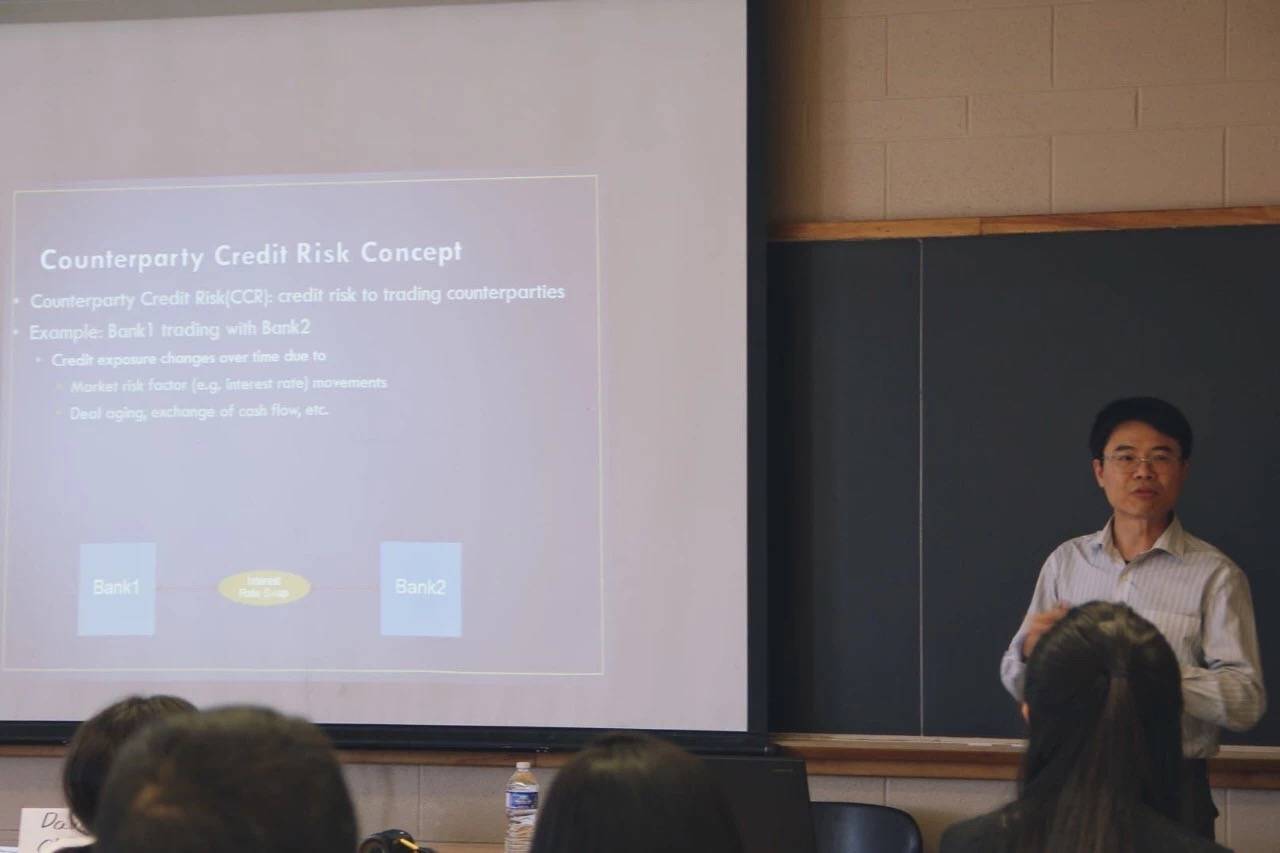On May 17, 2018, New Horizon Career Club (NHC) held the second session of the 2018 Risk Salon, which was about Counterparty Credit Risk (CCR). The audience had a great opportunity to hear the expert opinions about CCR, shared by panelists from the risk management and front office groups of major Canadian banks.
Mr Xun Ma (Senior Manager, Trading Risk Model Development team, TD Securities) first introduced the conceptual framework of CCR. Counterparty Credit Risk is the credit risk to trading counterparties.
 The main focus of CCR is the calculation of the potential future exposure (PFE), which measures the loss experienced by one counterparty, if the other one defaults. The credit exposure changes over time due to the movements of underlying market risk factors (for example, equity prices, interest rates, etc.) and deal aging.
The main focus of CCR is the calculation of the potential future exposure (PFE), which measures the loss experienced by one counterparty, if the other one defaults. The credit exposure changes over time due to the movements of underlying market risk factors (for example, equity prices, interest rates, etc.) and deal aging.
Modelling CCR consists of four major steps: risk factor calibration, generation of the risk factor scenarios (typically using Monte Carlo simulation), valuation of the trades on the scenarios, and calculation statistical measures, such as percentiles and conditional expectations, to obtain various CCR risk measures.

The second topic of Xun’s presentation was the Initial Margin (IM) and Variation Margin (VM). While VM is conceptually similar to a collateral amount and is required to be posted/pledged by the counterparties when the trade starts, IM is a relatively new concept that represents a VaR-like measure to capture potential settlement risk.
As a part of collateralization/margin requirements, IM is an important way of mitigating CCR and avoiding losses during the liquidation of assets after defaults. Xun explained that one of the main challenges of IM modelling is the necessity for both counterparties to reconcile their VaR models and to reach an agreement on the IM amount. Fortunately, the International Swaps and Derivatives Association (ISDA) has developed a highly standardized model for IA – Standard Initial Margin Model (SIMM). The back-testing and benchmarking results show that the SIMM is conservative compared to both the historical VaR IM model and the Central Counterparty (CCP) IM models.
 After the presentation, Mr Dmitri Rubisov (Managing Director, Capital Markets, BMO) kicked off a panel discussion, where Mr Xun Ma was joined by Mr Hovik Tumasyan (Lead Qaunt, Global Analytics and Financial Engineering, Scotia Bank) and Mr David Chan (Director, Cross Business Risk, BMO Capital Markets).
After the presentation, Mr Dmitri Rubisov (Managing Director, Capital Markets, BMO) kicked off a panel discussion, where Mr Xun Ma was joined by Mr Hovik Tumasyan (Lead Qaunt, Global Analytics and Financial Engineering, Scotia Bank) and Mr David Chan (Director, Cross Business Risk, BMO Capital Markets).
The first question Dmitri asked was what impacts the IM requirement would bring. The panelists discussed the potential impacts of the new regulatory requirement for IM from various aspects. For example, since large amounts of collateral would be required for IM posting, there might be liquidity drain for the markets of eligible collateral assets. From the modelling perspective, simulating IM within the framework of CCR /xVA model is very computationally intensive. This is currently a very active and interesting research area.
 Following Dmitri’s questions, the audience asked about the possibility that the SIMM approach could be over-conservative, forcing the bank to post more collateral than actually needed. This would require proactive liquidity risk management. It will also likely increase the credit limit line for trading derivatives and hence potentially decrease the market transaction amounts. According to the panelists, there is no unique way of measuring the conservativeness of the IM model. The SIMM approach provides a transparent and standard way of IM calculation for different counterparties.
Following Dmitri’s questions, the audience asked about the possibility that the SIMM approach could be over-conservative, forcing the bank to post more collateral than actually needed. This would require proactive liquidity risk management. It will also likely increase the credit limit line for trading derivatives and hence potentially decrease the market transaction amounts. According to the panelists, there is no unique way of measuring the conservativeness of the IM model. The SIMM approach provides a transparent and standard way of IM calculation for different counterparties.
Great thanks to all the panelists Xun, Hovik and David for providing those great insights to the audience and special thanks to Dmitri for being an excellent moderator!
 *This review is written by Ning Song
*This review is written by Ning Song
Ning Song is graduated from the Master of Quantitative Finance program at University of Waterloo. She is working on counterparty credit risk model validation at BMO Financial Group.

